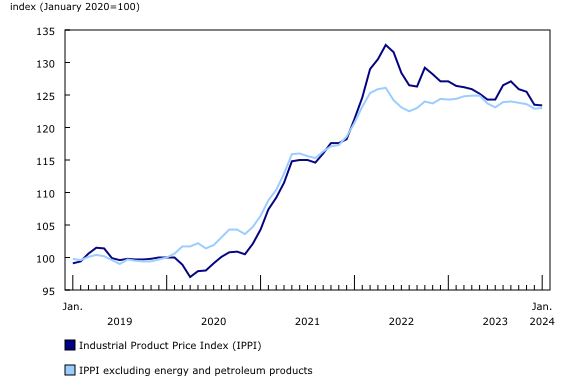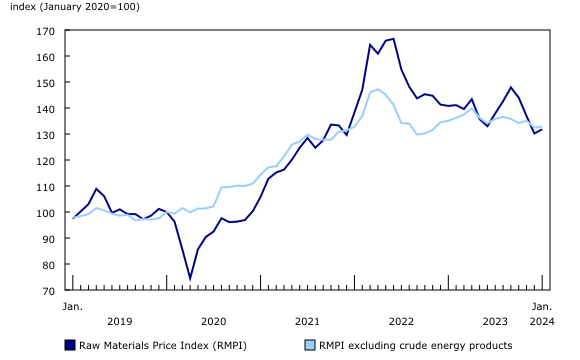Industrial product and raw materials price indexes, January 2024
Released: 2024-02-19
Prices of products manufactured in Canada, as measured by the Industrial Product Price Index (IPPI), edged down 0.1% month over month in January and were 2.9% lower than in January 2023. Prices of raw materials purchased by manufacturers operating in Canada, as measured by the Raw Materials Price Index (RMPI), increased 1.2% on a monthly basis in January 2024 and decreased 6.4% year over year.
Industrial Product Price Index
The IPPI edged down 0.1% month over month in January, the fourth consecutive monthly decline.
Prices for meat, fish and dairy products decreased 2.8% month over month in January, mainly due to lower prices for fresh and frozen beef and veal (-5.4%) and fresh and frozen chicken (-12.9%). Prices for fresh and frozen pork (-1.4%) also contributed to the decrease, but to a lesser extent. Beef prices primarily fell due to weak seasonal demand. Beef supply in Canada remained tight, although the supply shortage softened in the United States, with higher-than-expected production in the fourth quarter of 2023 and increased monthly cold storage in December, according to the United States Department of Agriculture (USDA). Chicken prices continued to fall in January 2024, mainly because of abundant supply and relatively low seasonal demand. According to Agriculture and Agri-Food Canada, chicken storage in January was 18.0% higher than in January 2023.
The prices for energy and petroleum products fell 0.7% month over month in January 2024. Despite the price of crude energy products (+3.0%) increasing, prices declined for refined petroleum energy products (-1.2%), including diesel fuel (-2.1%), jet fuel (-2.8%) and light fuel oils (-1.4%). Strong refining activity and weaker demand from the manufacturing and trucking sectors helped rebuild distillate fuel inventories in the United States to normal levels in January. According to Natural Resources Canada, diesel refining margins decreased 7.9% month over month in January, from 51.8 cents per litre to 47.7 cents per litre.
Prices for primary non-ferrous metal products decreased 0.8% in January, following a 0.7% drop in December. Prices for unwrought gold, silver, and platinum group metals, and their alloys, fell 2.5% month over month in January, mainly due to lower prices for unwrought silver and silver alloys (-4.4%) and unwrought platinum group metals, and their alloys (-4.5%). Strength in the US dollar and anticipation of continued high interest rates weighed on silver prices in January. Platinum group metal prices fell recently, partly due to uncertainty about future demand for palladium, a metal which is used primarily in fossil fuel powered vehicles, as the market shifts towards electric vehicles. In contrast, higher prices for unwrought aluminum and aluminum alloys (+3.7%) moderated the decrease in the primary non-ferrous metal products group. After the United Kingdom sanctioned Russian aluminum in December, speculation that the European Union could follow suit contributed to elevated aluminum prices in January.
Prices for intermediate food products fell 2.7% month over month in January, driven by lower prices for oilseed cake and meal (-12.1%) and canola or rapeseed oil (-4.5%). The decline in oilseed cake and meal prices can be attributed to the sluggish demand for soybeans and the anticipation of a higher supply from South America. Despite strong domestic demand, the canola price decreased due to weak export demand for Canadian canola.
The price of softwood lumber rose 4.2% in January. This was the third straight month-over-month increase and the largest growth since July 2023 (+11.3%). The recent increase in Canadian housing starts and reduced domestic supply of lumber in the long term both played a part in the rise of lumber prices. According to Canada Mortgage and Housing Corporation, the monthly seasonally adjusted annual rate of total housing starts in Canada rose 18.2% from November to December. Lumber production fell 6.6% over the first 11 months of 2023 compared with the same period in 2022.
Year over year
The IPPI decreased 2.9% year over year in January 2024.
Prices for energy and petroleum products declined 15.7% on a year-over-year basis in January, led by diesel fuel (-22.5%), finished motor gasoline (-12.6%) and jet fuel (-27.1%).
Excluding energy and petroleum products, the IPPI declined 1.0% year over year in January. Key downward contributors to the price movement were unwrought nickel and nickel alloys (-42.9%), grain and oilseed products, n.e.c. (-19.8%), other unwrought non-ferrous metals and non-ferrous metal alloys (-23.1%) and wood pulp (-18.1%).
Prices for light-duty trucks, vans and sport utility vehicles (+1.9%), other fabricated metal products (+11.4%) and softwood lumber (+4.0%) rose year over year in January, moderating the decline in the RMPI.
Raw Materials Price Index
In January, the RMPI increased 1.2% month over month, after posting three consecutive declines.
The prices of crude energy products (+3.0%) drove the January increase in the RMPI. Conventional crude oil prices were up 2.8% in January, following a 9.2% decrease in December. The risk to oil transportation caused by shipping disruptions in the Red Sea had an upward impact on prices. In mid-January, winter storms in the United States and Canada further contributed to the price increases by temporarily slowing production.
Lower prices for crop products (-2.3%) partially offset the RMPI's increase in January. Canola prices (-5.0%) led the group. Prices for other crop products (-1.2%) also fell, especially for grains (except wheat) (-2.3%), with corn for grain prices decreasing 4.2%. According to the USDA, global corn production is expected to rise for the 2023/2024 crop year, which is likely influencing prices.
Year over year
The RMPI decreased 6.4% year over year in January.
Conventional crude oil (-9.1%) was the biggest driver of the RMPI movement in January. Nickel ores and concentrates (-41.3%), synthetic crude oil (-17.3%) and canola (including rapeseed) (-25.9%) were other key contributors to the decrease.
Major upward contributors to the RMPI's year-over-year change in January included cattle and calves (+21.3%), and gold, silver, and platinum group metal ores and concentrates (+4.2%).
Did you know we have a mobile app?
Get timely access to data right at your fingertips by downloading the StatsCAN app, available for free on the App Store and on Google Play.
Note to readers
The Industrial Product Price Index (IPPI) and the Raw Materials Price Index (RMPI) are available at the Canada level only. Selected commodity groups within the IPPI are also available by region.
With each release, data for the previous six months may have been revised. The indexes are not seasonally adjusted.
The IPPI reflects the prices that producers in Canada receive as goods leave the plant gate. The IPPI does not reflect what the consumer pays. Unlike the Consumer Price Index, the IPPI excludes indirect taxes and all costs that occur between the time a good leaves the plant and the time the final user takes possession of the good. This includes transportation, wholesale and retail costs.
Canadian producers export many goods. Canadian producers often indicate goods' prices in foreign currencies, especially in US dollars, which are then converted into Canadian dollars. This is particularly the case for motor vehicles, pulp and paper products, and wood products. Therefore, fluctuations in the value of the Canadian dollar against its US counterpart affect the IPPI. However, the conversion to Canadian dollars reflects only how respondents provide their prices. This is not a measure that takes into account the full effect of exchange rates.
The conversion of prices received in US dollars is based on the average monthly exchange rate established by the Bank of Canada and available in Table 33-10-0163-01 (series v111666275). Monthly and annual variations in the exchange rate, as described in the release, are calculated according to the indirect quotation of the exchange rate (for example, CAN$1 = US$X).
The RMPI reflects the prices paid by Canadian manufacturers for key raw materials. Many of those prices are set on the world market. However, as few prices are denominated in foreign currencies, their conversion into Canadian dollars has only a minor effect on the calculation of the RMPI.
Products
Statistics Canada launched the Producer Price Indexes Portal as part of a suite of portals for prices and price indexes. This webpage provides Canadians with a single point of access to a variety of statistics and measures related to producer prices.
The video "Producer price indexes" is available on the Statistics Canada Training Institute webpage. It introduces Statistics Canada's producer price indexes: what they are, how they are made and what they are used for.
Next release
The industrial product and raw materials price indexes for January will be released on March 18.
Contact information
For more information, or to enquire about the concepts, methods or data quality of this release, contact us (toll-free 1-800-263-1136; 514-283-8300; infostats@statcan.gc.ca) or Media Relations (statcan.mediahotline-ligneinfomedias.statcan@statcan.gc.ca).
- Date modified:




